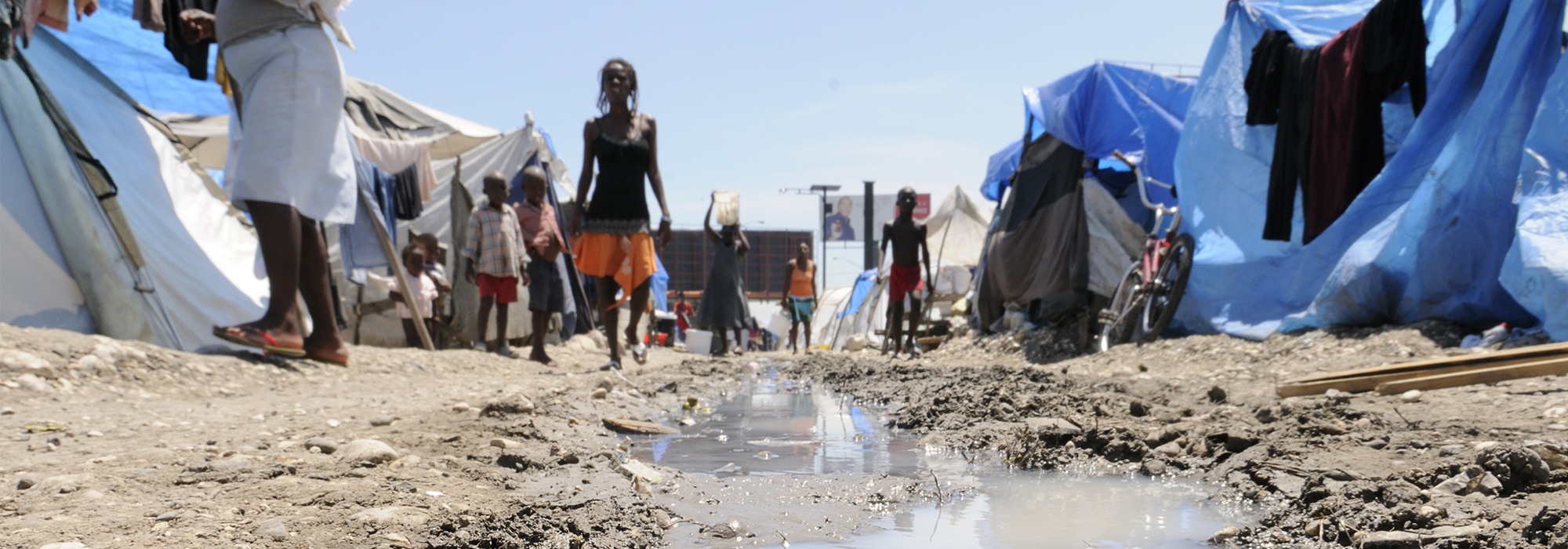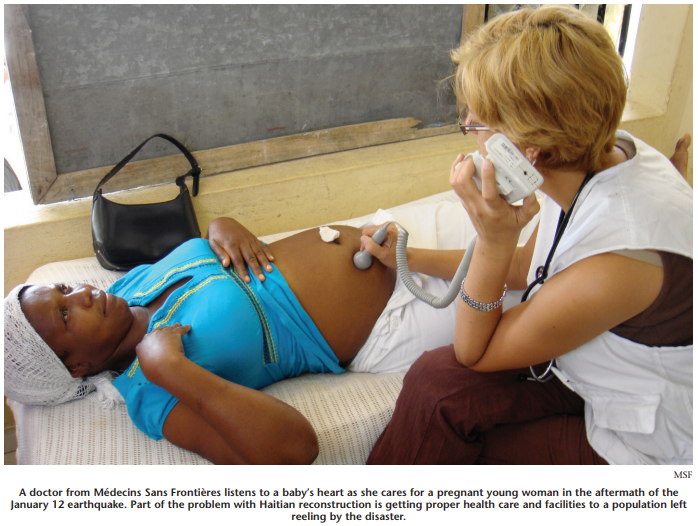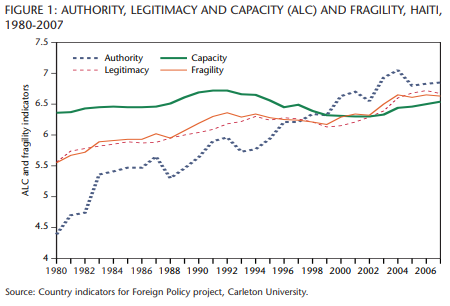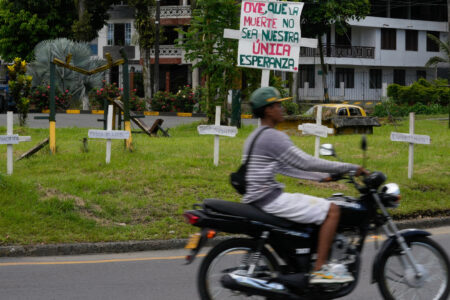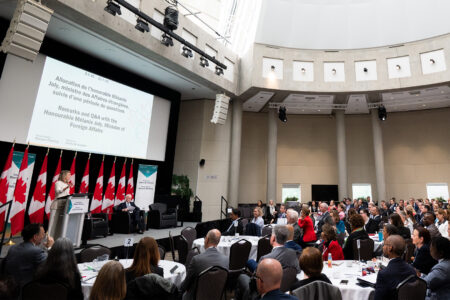
Recent efforts such as the one by Allan Rock, former Canadian foreign minister and now president of the University of Ottawa, to harness the combined energies of Canada’s Haitian diaspora, eager Canadian NGOs, like-minded academics and foreign affairs specialists are well intentioned but not carefully thought out, and at worst, misplaced. The most important attribute of Rock’s plan would feature Canadian experts working alongside Haitians to support indigenous efforts to rebuild the country. We wonder if such a strategy — premised on a faddish development agenda that supports existing political structures, reinforces corrupt leadership and stresses local ownership and decision-making processes in such a fragile environment as Haiti’s — is likely to be effective. Nowhere is a dose of paternalism more needed than in Haiti, a country that lacks all the attributes of a normally functioning state.
Haiti’s history is one of extreme poverty and fragility. Before the earthquake struck, Haiti was the only country in the western hemisphere that was at risk of failing to meet seven of the eight Millennium Development Goals, including increasing gender equality and education and reducing extreme poverty and hunger, child mortality and maternal mortality, putting the country in an unenviable category usually occupied by the failed states of Africa.
The difficulties that it faced in the immediate aftermath of the earthquake, in terms of rescue efforts and aid coordination on the ground, stem from deep underlying weaknesses in governance, human development, economic development, and security that were in place many decades before the earthquake struck. Poverty and fragility meant that security was never guaranteed, that property rights have been virtually nonexistent, that there were no building codes, that construction quality standards were not respected and that successive governments were too weak to enforce whatever standard was in place. For most of Haiti’s contemporary history, its governments and leaders have failed to provide security to their people, to promote economic freedom and to encourage entrepreneurship. The result is an extremely weak formal economy that has entrenched corruption and is heavily dependent on external assistance, and a large informal sector where most people are barely surviving. Why should one then be surprised about the degree of deforestation and environmental degradation as well as the poor quality of construction in that country, when basic property rights are not respected?
As another example of what poverty and fragility can do, consider the earthquake that hit Chile (an upper-middle-income country, according to the World Bank classification of countries) on February 27 and was several hundred times stronger than the one that hit Haiti. Any loss of life from natural catastrophes is terrible, but the numbers in the case of Chile pale in comparison to the Haitian death toll. It took only a few hours for Chilean President Michelle Bachelet to organize a press conference to update the Chilean population about the situation and to inform the international community that her country did not immediately need foreign assistance. President René Préval, on the other hand, took days before making a first postquake address. Haitians who were interviewed in the ruins of Port-au-Prince on international news channels in the hours and days after the earthquake hit were all asking for external assistance; over the years, they had grown accustomed to not expecting anything from their own government. It should come as no surprise that the United Nations Development Programme’s Disaster Risk Index, a calculation we use to assess overall environmental risk, put Haiti in the very high risk category before the earthquake struck.
Prime Minister Stephen Harper has already indicated that Haiti will remain a long-term priority for the government, and that Canada will not leave until the job is done. The commitment itself is not surprising. After all, before the earthquake hit, Haiti was already Canada’s largest recipient of aid in the western hemisphere and second globally behind Afghanistan. Haiti represents a nice mix of opportunity and interest for Canada’s diplomats to test out their recently restructured Stabilization and Reconstruction Task Force (START), which, up until now, has been essentially sidelined by a variety of country-specific task forces, such as the one dedicated to the rebuilding of Afghanistan. Furthermore, Canada has had a fairly long, albeit mixed, history of carrying out humanitarian, security and development operations in Haiti, through the Canadian International Development Agency (CIDA) and the RCMP in particular. There is also a sizable Haitian diaspora in Canada, most of whom live in Quebec and who are eager to help. At face value, and for a variety of reasons then, Haiti seems to align well with the current government’s foreign policy priorities: ensuring the Caribbean is a secure and stable place for free trade and economic growth, building domestic support by drawing on diaspora group interests and funds, and a peacekeeping presence. One can assume therefore that Canada will be one of the key players in the process of reconstruction and development in Haiti over the next few years. But are we really prepared for the job?
Poverty and fragility meant that security was never guaranteed, that property rights have been virtually nonexistent, that there were no building codes, that construction quality standards were not respected and that successive governments were too weak to enforce whatever standard was in place.
Since its independence, Haiti has had a troubled economy. Even by historical standards, however, its recent experiences have been particularly traumatic. It is the only non-African country other than Afghanistan that is consistently ranked among the top 10 on the CIFP’s fragile states index. In fact, Haiti has failed to achieve any real growth and development over the last several decades. Its GDP per capita in 2008 of US$1,087 was roughly half of what it was in 1980, and life expectancy at birth is 61 years; the corresponding numbers for its immediate neighbour, the Dominican Republic, are US$7,600 and 72 years. Using data from the Development Assistance Committee of the OECD, we calculated that Haiti had received US$8.9 billion in foreign aid over the period 1960 to 2008, yet it is ranked 149th out of 182 countries on the latest Human Development Index, with 72 percent of its population living on less than $2 a day and 42 percent not using an improved water source. In addition to Haiti’s many poverty-driven problems, there are also issues related to the extreme inequality that exists in the country. Haiti has an extremely small, mostly French-speaking elite that nonetheless dominates much of the country’s assets; most measurements of income inequality place Haiti at or near the bottom of the list of developing countries.
Haiti also suffers from a range of macroeconomic problems, including extreme and chronic lack of liquidity. Its levels of foreign direct investment and foreign aid improved somewhat in the latter half of the 1990s, but collapsed again in the wake of Aristide’s 2000 reelection and the resulting American decision to suspend all bilateral aid. Aid flows have been on the rise again in the past few years. Haiti’s industry has gradually decayed since the early 1990s and was only recently slightly revived through the Hemispheric Opportunity through Partnership Encouragement Act. Haiti’s other traditional exports are largely agricultural, including cash crops such as sugar cane, coffee and mangoes. These continue to suffer due to international agriculture tariffs as well as increased competition from new market players such as Vietnam. There are few other sources of economic growth within the country; as a result, Haitians have had increasingly to turn to other sources of income, including international remittances and, in more extreme cases, illicit activities such as corruption, kidnapping and drug trafficking. Transparency International ranked Haiti 168th out of 180 countries in its 2009 Corruption Perceptions Index, which measures the perceived level of public sector corruption. Criminal activities are becoming increasingly transnational in character; the activities of Haitian organized crime gangs are becoming a matter of increasing importance for Canada.
Despite seeing a large part of its debt written off as a result of reaching the completion point of the Heavily Indebted Poor Countries Initiative in June of last year, Haiti still owed US$1.25 billion in debt in 2009, (according to International Monetary Fund (IMF) data. Of this amount, the biggest creditors were the InterAmerican Development Bank (34 percent) and Venezuela’s Petrocaribe (24 percent). However, following the earthquake, President Hugo Chávez has announced that Venezuela will cancel Haiti’s debt. Given Haiti’s poor track record, one has to wonder what all these loans have accomplished. As usual, misinformed debt relief advocates have been quick to join the debt cancellation bandwagon, failing to realize that, according to the IMF, Haiti would only have serviced its debt to the tune of US$18 million in 2009/10, US$20.3 million in 2010/11, US$33.8 million in 2011/12 and US$48 million in 2012/13. In other words, with debt cancellation, very modest amounts will be freed compared to what the country needs to rebuild. Providing grants and not loans to Haiti, as World Bank President Robert Zoellick has recently proposed, makes sense, but clear timelines and accountability mechanisms should also be established. Interestingly, Zoellick also mentions that the World Bank has cancelled Haiti’s debt repayments for the next five years and that others should do the same. We estimated how much saving this World Bank initiative would represent using data from the IMF — the result: US$0.7 million over the period 2009-2013! We also caution against Zoellick’s idea of channelling more money through the budget or his faith in “strong Haitian leadership,” when the evidence clearly shows that the current government is extremely weak.
Like the debt relief activists, those from the “more aid” camp have also been quick to respond. Paul Collier, former economist at the World Bank and now at the University of Oxford, has made an interesting argument for a new Marshall Plan for Haiti. As the UN’s special rapporteur on Haiti, Collier wants the West to invest several billions of dollars in the country. Jeffrey Sachs, another prominent development economist and a strong proponent of a massive scaling-up of foreign aid generally, recommends the creation of a single-donor recovery fund for Haiti of $10 to $15 billion over the next five years for a reconstruction plan to be managed by the InterAmerican Development Bank. According to Sachs, this fund should be overseen by a board that includes members appointed by Haitian President René Préval, the UN Secretary General and donors. A management team would devise and implement plans, in agreement with the Haitian government. As we and others have argued elsewhere, such strategies must be questioned at the outset before they gain currency.
In his Harvard University commencement speech of June 1947, George C. Marshall, then US secretary of state, laid the foundations for the European Recovery Program, or Marshall Plan, to rebuild Europe after the ravages dealt to it during the Second World War. His view was that assistance “must not be on a piecemeal basis as various crises develop” and “should provide a cure rather than a mere palliative.” He went on to argue that “on its way to recovery, there must be some agreement among the countries of Europe as to the requirements of the situation and the part those countries themselves will take in order to give proper effect to whatever action might be undertaken by this [i.e., the US] Government…The Initiative, I think, must come from Europe.” If the Marshall Plan did cause Europe to grow, it was because Europe had a number of favourable preconditions for it to work, including high levels of human capital, a long history of democratic institutions and rule of law, private enterprise and trading history. Unfortunately, none of these preconditions are present in Haiti.
Other factors underlying Haiti’s current instability stem from its underlying demographic structure. For instance, Haiti’s youth bulge — namely, the proportion of the population under the age of 15 — is a cause for concern. Particularly disturbing is the number of cases of child domestic labour, sometimes approaching child slavery. In Haiti, domestic children are called restavèk. They become house slaves when they are turned over by their parents to another family, which agrees to care for the children and provide schooling, food, shelter and clothing in exchange for domestic labour. In reality, the restavèk spend their formative years isolated, deprived of schooling and subject to long days of work with no pay, and living conditions inferior to those of the overseer’s family. This bodes particularly ill for Haitian stability, as young unemployed or underemployed males are by far the demographic most likely to engage in criminal activity, terrorism and insurgency actions; it is precisely this demographic that is growing in Haiti. Of the 10 measures used to assess Haiti’s demographic stress, 6 are at very high risk, including population growth rate, percentage of slum population, migration, life expectancies and urban growth rate.
Much of the extreme degradation of Haiti’s environment, particularly its level of deforestation, can be explained by these demographic factors; it is also a direct result of the levels of poverty in the country. For decades, rural Haitians have been forced to turn to local forests as a source for cooking fuel in the absence of reliable and affordable alternatives. In 2000, the island nation had 880 square kilometres of forest, covering just 3.2 percent of the total land area. The remaining forest was disappearing at a rate of over 5 percent per year. Without significant tree cover, the land cannot absorb even moderate levels of rainfall. Thus, whereas other nations may not be unduly disturbed by a given storm, Haiti is likely to be deeply affected. When intense phenomena such as tropical storms hit the country, the result is inevitably tragic.
Given the wide range and extent of problems facing Haiti, some important lessons can be drawn from the research we have conducted on fragile states. From a policy perspective, fragile states are an important area of study for several reasons. First, they are by definition characterized by weak or nonexistent policy environments, which makes engagement in them a long-term challenge. Second, the level of structural complexity found in these states makes policy entry and prioritization difficult. Third, it is extremely costly to neglect fragile states and wait for them to begin failing or collapse completely before intervening, which unfortunately was what we did before the earthquake. To be sure, the international community was deeply involved in helping Haiti for many decades. But the country’s extreme vulnerability in the aftermath of the quake shows how deficient and misplaced these efforts really were. Indeed, the costs are only now being properly understood. There are obvious impacts on poverty and Haitian well-being, but neighbouring countries and the international community are also affected when leadership proves incapable of fulfilling basic responsibilities to its peoples. Fourth, the populations living in fragile states are farther from achieving the Millennium Development Goals than any others on the planet. Even when some progress is made in unstable environments, there is a continuing danger; as long as stability eludes such states, small gains may be wiped out at any time by instability, governmental failure or conflict, further frustrating efforts to reduce global poverty.
For decades, rural Haitians have been forced to turn to local forests as a source for cooking fuel in the absence of reliable and affordable alternatives. In 2000, the island nation had 880 square kilometres of forest, covering just 3.2 percent of the total land area. The remaining forest was disappearing at a rate of over 5 percent per year. Without significant tree cover, the land cannot absorb even moderate levels of rainfall.
Haiti is the archetype of an extremely fragile state, one where the state has for many years ceased to exhibit the core properties of authority, legitimacy and capacity (ALC) that should be present in any functioning state. In our own research on state fragility, we have used this ALC framework to produce a fragility index and composite measures of authority, legitimacy and capacity for all countries around the world, as part of the Country Indicators for Foreign Policy (CIFP) project. Authority captures the extent to which a state possesses the ability to enact binding legislation over its population, to exercise coercive force over its sovereign territory, to provide core public goods and to provide a stable and secure environment to its citizens and communities. Legitimacy refers to the extent to which the governing regime is accepted domestically and internationally. Capacity measures the ability of a state to mobilize and employ resources toward productive ends. A combination of ineffective authority, weak legitimacy and poor capacity mean that Haitian leadership is unable to respond effectively to sudden shocks such as natural disasters, epidemics, food shortages and internal conflict.
Our assessment using the ALC framework indicates that Haiti’s performance has been appalling when compared to the global sample of countries. It was ranked among the top 10 fragile states over the period 198394, among the top 20 for most of the period 1995-2003 and again among the top 10 over the period 2004-07; its fragility score has deteriorated by 20 percent over the full period. The small gains that were made in rare periods of relative stability were quickly erased as a result of a combination of political instability, poor economic policies and natural disasters.
Let us examine figure 1 below, keeping in mind that an increasing trend is associated with increasing fragility and deterioration in the ALC components. Capacity scores have always been very high (poor) in the case of Haiti and are also the least susceptible to rapid fluctuations. However, authority structures have worsened so much, followed by legitimacy, that they are now largely responsible for the fragility of the country. Except for capacity scores, there is a clear upward trend line in all other components. Ironically, since Jean-Bertrand Aristide was forced out of office in 2004, it was often reported that this marked a new beginning for Haiti and that the current government was the most legitimate that Haiti had seen in decades; sadly, our data do not show any significant improvement over the 2004-07 period. Furthermore, the storms that hit the country in 2008 as well as the recent earthquake will likely worsen capacity scores further over the short to medium term.
In the case of fragile states such as Haiti, our research on aid allocation and aid effectiveness has yielded several insights that are very helpful here. When one considers the top 20 or top 40 fragile states in the world, they tend to be underaided as a group. However, within the group of fragile states, one can find some that are overaided, with the potential of negative returns to development due to limited absorptive capacity. Aid flows per capita to fragile states tend to be also very volatile over time. We have found that aid has not had a significant impact on growth in fragile states and that there are diminishing returns to aid. Absorptive capacity is the key issue for most fragile states, and Haiti is no exception. Massive amounts of aid applied over a short period of time simply cannot be effectively and properly absorbed by a country that lacks the rudiments of effective government, critical infrastructure and basic control over its territory and people. When aid starts to flow in large amounts, managing the macroeconomy becomes more difficult (for example, as real exchange rates appreciate, or as aid substitutes for government revenues, thus reducing incentives for taxation); government institutions are weakened (for example as human resources are allocated to aid programs or as recipients focus on donors’ needs rather than the needs of their populations); and bottlenecks are created when complementary factors such as basic institutions and infrastructure are missing. A large number of uncoordinated donors on the ground may undermine each other as well as the intended recipient.
Studies that find evidence of diminishing returns to aid (or saturation points) find that aid stops having a positive impact on growth at anywhere from 15 to 45 percent of the recipient country’s GDP. In Haiti’s case, this number was 13.1 percent in 2008 and is set to increase considerably in the next few years. Consider the following back-of-the-envelope calculations. Assume that aid flows are in the order of US$2 to $3 billion per year (as recommended by Jeffrey Sachs) over the next five years, starting in 2010. Assume also for the time being that GDP is at the level predicted by the IMF for 2010 and 2011, which does not take into consideration any damage done by the earthquake and is obviously unrealistic. This results in aid/GDP ratios of the order of 27 to 40 percent for 2010 and 25 to 38 percent for 2011. If we factor in the damages resulting from the earthquake — which, according to World Bank estimates, will amount to 15 percent of the country’s GDP (and these numbers are seen by many as too conservative) — and assume the same growth rates predicted by the IMF (again unrealistic but to keep things simple), the aid/GDP ratios are of the order of 32 to 48 percent for 2010 and 31 to 46 percent for 2011. Clearly, a massive scaling-up of aid to Haiti, as recommended by Jeffrey Sachs and others, will take it well into the territory where diminishing returns to aid become a real possibility.
In order for aid to be effective, Canada needs a strategy that clearly lays out the sequencing of and support for building political authority, legitimate governance and sound economic capacity over time, which are all desperately lacking in Haiti. Recent calls by the US administration for democratic elections to be held immediately are mere window dressing and are unlikely to generate any long-term economic effects. We suggest that if Canada is going to be a key player in rebuilding the country, our first objective should be increased capacity, focusing on economic development and reinstating and creating basic services to its people. Second, providing security through proxy in order to reestablish effective authority and control over territories and people will be essential. Finally, only after authority and capacity have been stabilized should democracy be reintroduced to the country. After all, how is it that a leadership that was utterly incapable of providing for its people before and during the earthquake can be considered legitimate? It will take years if not decades to introduce less corrupt forms of leadership to Haiti.
To meet these goals, an effective Canadian development strategic plan could begin by specifying the end results that are expected from our investments, the risks in achieving those results and indicators that track a reduction in those risks over time. In brief, a road map is useful only if you know your final destination. Careful and precise diagnosis, using the monitoring, threat and risk assessment tools developed by the CIFP project and funded by the Canadian government, can be the route to success. For example, to measure effectiveness, donors will need a much more precise monitoring capability than they currently use. Canada cannot operate in the dark — though it often does. Indeed, we lag behind both the UK’s Department for International Development and the United States Agency for International Development in terms of deploying sophisticated impact assessment tools that use precise controlled experimentation to measure aid effectiveness. If indeed the Canadian government is going to make Haiti our country’s number one development priority over the next several years, and perhaps the next decade, then we have an opportunity to use the tools Canada has invested in to systematically and carefully evaluate the impact our investments are having on Haiti. Haiti is our test case for “getting aid right,” and getting aid right means the effective, relevant and costed deployment of resources.
We also need to recognize that Haiti’s problems are more than just development-related. There are security and regional considerations that must be factored into our policies. Typically the collapse of a state has deleterious effects on its neighbours and the region, and Haiti is no exception. For example, Haiti is a major transit point for narcotics trafficking. That “role” will shift elsewhere with the possibility of destabilizing Jamaica, another country that receives large amounts of Canadian aid. In brief, it would be unwise for our policy-makers to think about rebuilding Haiti without giving due consideration to all aspects of Haitian political and economic development and the major impediments therein. Such judgments require coordination and coherence across our three departments of defence, development and diplomacy and, above all, strong leadership to ensure they are all working from the same road map.
Our fragile states research, in which Haiti figures prominently, provides a more sobering assessment of its precarious situation. Should we chart a course that takes Collier’s, Sachs’ and Rock’s recommendations seriously, Haiti will remain a high risk concern with a strong probability of falling back into chaos. International aid will largely be used to buy commodities and achieve “quick, highly visible wins” palatable to Canadians at home rather than being invested in sustainable development. Security and rule of law will continue to be areas of concern and the international community will continue to be the primary security provider for the country. In a worst-case scenario for Haiti, conditions will continue to deteriorate rapidly. Aid will be redirected toward stopgap peacekeeping measures. Benefits will continue to accrue to the French-speaking elite while the large Creole-speaking population continues to live in severe poverty. Aid will eventually be reduced and withdrawn because of allegations of corruption.
The continuing inability of the Haitian police force to provide basic security can be traced both to its difficult role in recent Haitian history and to more mundane considerations such as a lack of equipment, training, resources and infrastructure.
These sobering assessments stem from several underlying features, including our evaluation of security, rule of law, human rights and the economy. Consider security, which has long been a pivotal issue in Haiti. The continuing inability of the Haitian police force to provide basic security can be traced both to its difficult role in recent Haitian history and to more mundane considerations such as a lack of equipment, training, resources and infrastructure. Police corruption and lack of capacity have forced the international community to assume security functions since 2004. The lack of functional judicial and corrections systems also continues to be of concern. The judicial system, for example, has poorly paid and poorly trained judges. There is no national registry of court cases and long pretrial detentions are the norm. An antiquated Napoleonic code allows arrests only when a criminal is caught in the act. The reality is that, as long as unemployment is high and economic opportunities are few, criminality will remain attractive.
Corruption and lack of independence within the judicial system also contributes to the instability of the political system, further weakening government checks and balances. With no independent body able to review government actions, Haitians have little choice but to hope that the elected president remains committed to democracy and broadbased economic growth. Although Haiti features a relatively rural population by regional standards, the capital of Port-au-Prince tends to dominate political decision-making within the country. As a result, many regions are excluded from efforts to enhance economic and social benefits; this increases discontent and reduces the legitimacy of the central government. Further, although the government of Haiti ostensibly controls all areas of the country, in reality many rural jurisdictions are under the de facto control of local individuals or groups. In some cases, these groups use this control to dominate the local population.
As much-needed humanitarian assistance continues to flow to Haiti over the next few months, it is important to develop a carefully thought-out strategy for long-term sustainable development. Should Canada decide to make Haiti its number one priority over the next few years, this may well be our test case for “getting aid right” in a very difficult and challenging environment. Since the task ahead is so big, a first step would be to set realistic goals over the next chosen number of years with a costed deployment of resources. It is probably better to do fewer things well with a more modest aid budget than to try to do everything at once. Due to weak authority and legitimacy structures, a dose of paternalism will be necessary over the short to medium term; otherwise, the probability of failure will be very high.
With the projected freeze on Canadian foreign aid spending starting in 2011, we have a collective responsibility to make sure that the allocation of every single dollar spent is carefully monitored. Impact assessment tools need to be applied at every stage and we should consider revising or withdrawing aid if effects are not achieved. Elites and patronage systems in place in Haiti need to be avoided, and rather than focusing primarily on aid as a long-term solution (which has done very little for poverty reduction and development in that country), we need to start thinking more broadly. For example, harnessing the potential of remittance flows and tracking them better, as well as providing more market access for Haitian products, may be better options than providing massive amounts of aid to a country that can clearly not absorb them efficiently in a short period of time.
Photo: arindambanerjee / Shutterstock



